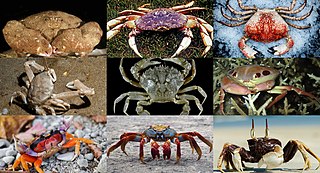
Crabs are decapod crustaceans of the infraorder Brachyura, which typically have a very short projecting tail-like abdomen, usually hidden entirely under the thorax. They live in all the world's oceans, in freshwater, and on land, are generally covered with a thick exoskeleton, and have a single pair of pincers on each arm. They first appeared during the Jurassic period, around 200 million years ago.

The yellow crazy ant, also known as the long-legged ant or Maldive ant, is a species of ant, thought to be native to West Africa or Asia. They have been accidentally introduced to numerous places in the world's tropics.

The Japanese spider crab is a species of marine crab and is the biggest one that lives in the waters around Japan. At around 3.7 meters, it has the largest leg-span of any arthropod. The Japanese name for this species is taka-ashi-gani,, literally translating to “tall legs crab”. It goes through three main larval stages along with a prezoeal stage to grow to its great size.
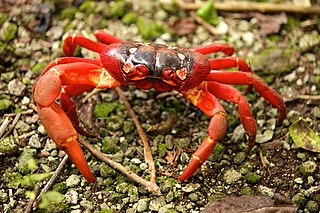
The Christmas Island red crab is a species of land crab that is endemic to Christmas Island and Cocos (Keeling) Islands in the Indian Ocean. Although restricted to a relatively small area, an estimated 43.7 million adult red crabs once lived on Christmas Island alone, but the accidental introduction of the yellow crazy ant is believed to have killed about 10–15 million of these in recent years. Christmas Island red crabs make an annual mass migration to the sea to lay their eggs in the ocean. Although its population is under great assault by the ants, as of 2020 the red crab had not been assessed by the International Union for Conservation of Nature (IUCN) and it was not listed on their Red List. The crab's annual mass migration to the sea for spawning is described as an "epic" event. Millions emerge at the same time, halting road traffic and covering the ground in a thick carpet of crabs.
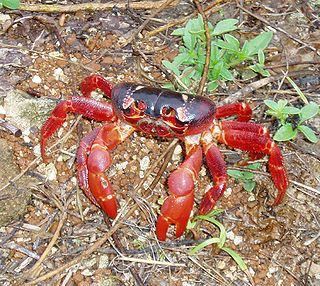
Gecarcoidea is a genus of terrestrial crabs. The crabs live in forests but must come to the coast to breed. When it is dry in the summer the crabs are inactive, but when it is the wet season they are ready to migrate.

Carcinus maenas is a common littoral crab. It is known by different names around the world. In the British Isles, it is generally referred to as the shore crab, or green shore crab. In North America and South Africa, it bears the name European green crab.

Mictyris is a genus of brightly coloured crabs, placed in its own taxonomical family, the Mictyridae. It inhabits the central Indo-West Pacific region. These crabs congregate on mud flats or beaches in groups of a few thousand, and filter sand or mud for microscopic organisms. They congregate during low tide, and bury themselves in the sand during high tide or whenever they are threatened. This is done in wet sand, and they dig in a corkscrew pattern, leaving many small round pellets of sand behind them.

The Diogenidae are a family of hermit crabs, sometimes known as "left-handed hermit crabs" because in contrast to most other hermit crabs, its left chela (claw) is enlarged instead of the right. It comprises 429 extant species, and a further 46 extinct species, making it the second-largest family of marine hermit crabs, after the Paguridae.
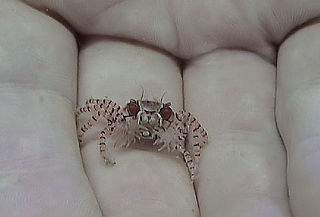
Lybia is a genus of small crabs in the family Xanthidae. Their common names include boxer crabs, boxing crabs and pom-pom crabs. They are notable for their mutualism with sea anemones, which they hold in their claws for defense. In return, the anemones get carried around, which may enable them to capture more food particles with their tentacles. Boxer crabs use at least three species of anemones, including Bundeopsis spp. and Triactis producta. The bonding with the anemone is not needed for survival, however, and boxer crabs have frequently been known to live without them, sometimes substituting other organisms such as sponges and corals for the sea anemones.

Chiromantes haematocheir, commonly known as red-clawed crab, is a species of mudflat crab in the family Sesarmidae. It is endemic to East Asia and is quite distinct from the other species placed in the genus Chiromantes. The genus may be restricted to this one species.

The coconut crab is a terrestrial species of giant hermit crab, and is also known as the robber crab or palm thief. It is the largest terrestrial arthropod known, with a weight of up to 4.1 kg (9 lb). The distance from the tip of one leg to the tip of another can be as wide as 1 m. It is found on islands across the Indian and Pacific Oceans, as far east as the Gambier Islands, Pitcairn Islands and Caroline Island and as far west as Zanzibar. While its range broadly shadows the distribution of the coconut palm, the coconut crab has been extirpated from most areas with a significant human population such as mainland Australia and Madagascar.

Hexapodidae is a family of crabs, the only family in the superfamily Hexapodoidea. It has traditionally been treated as a subfamily of the family Goneplacidae, and was originally described as a subfamily of Pinnotheridae. Its members can be distinguished from all other true crabs by the reduction of the thorax, such that only seven sternites are exposed, and only four pairs of pereiopods are present. Not counting the enlarged pair of claws, this leaves only six walking legs, from which the type genus Hexapus, and therefore the whole family, takes its name. Some anomuran "crabs", such as porcelain crabs and king crabs also have only four visible pairs of legs. With the exception of Stevea williamsi, from Mexico, all the extant members are found either in the Indo-Pacific oceans, or around the coast of Africa.
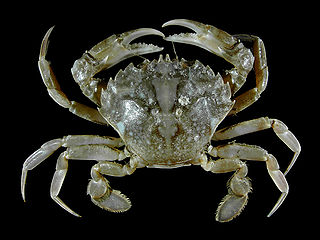
Eubrachyura is a group of decapod crustaceans comprising the more derived crabs. It is divided into two subsections, based on the position of the genital openings in the two sexes. In the Heterotremata, the openings are on the legs in the males, but on the sternum in females, while in the Thoracotremata, the openings are on the sternum in both sexes. This contrasts with the situation in other decapods, in which the genital openings are always on the legs. Heterotremata is the larger of the two groups, containing the species-rich superfamilies Xanthoidea and Pilumnoidea and all the freshwater crabs. The eubrachyura is well known for actively and constantly building its own burrows. The fossil record of the Eubrachyura extends back to the Cretaceous; the supposed Bathonian representative of the group, Hebertides jurassica, ultimately turned out to be Cenozoic in age.

Gecarcinus ruricola is a species of terrestrial crab. It is the most terrestrial of the Caribbean land crabs, and is found from western Cuba across the Antilles as far east as Barbados. Common names for G. ruricola include the purple land crab, black land crab, red land crab, and zombie crab.

Macropodia is a genus of crabs, belonging to the family Inachidae. It contains the following species:

Pugettia producta, known as the northern kelp crab or shield-backed kelp crab, is a species of crab in the family Epialtidae.
Jacforus cavatus is a species of crab in the monotypic genus Jacforus in the family Xanthidae.
Michèle de Saint Laurent was a French carcinologist. She spent most of her career at the Muséum national d'histoire naturelle in Paris, working on the systematics of decapod crustaceans; her major contributions were to hermit crabs and Thalassinidea, and she also co-described Neoglyphea, a living fossil discovered in 1975.

Around 65 species of crab occur in the waters of the British Isles. All are marine, with the exception of the introduced Chinese mitten crab, Eriocheir sinensis, which occurs in fresh and brackish water. They range in size from the deep-water species Paromola cuvieri, which can reach a claw span of 1.2 metres, to the pea crab, which is only 4 mm (0.16 in) wide and lives inside mussel shells.
Jacques Forest was a French carcinologist.

















